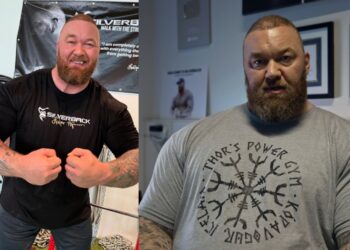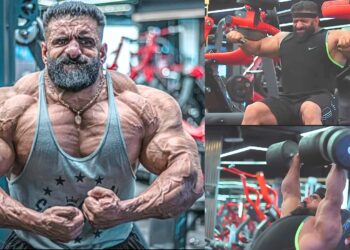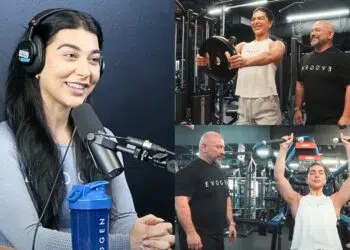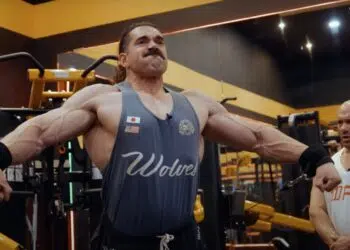Bodybuilding is a very healthy pastime. It improves fitness and strength, can reduce your stress levels, and may even ward off diseases such as diabetes, obesity, and osteoporosis (1). It also boosts your mood, builds self-confidence, and, of course, makes you look amazing too.
On the downside, bodybuilding can also be hard on your body and can be especially rough on your joints. Of all the joints affected by bodybuilding training, the shoulders are arguably the most susceptible to wear, tear, and injury. Why? Because almost every bodybuilding exercise involves the shoulder joint.
Because of this, shoulder problems are not just common, they can also stop you from training. Painful shoulder joints will affect your ability to train your chest, back, delts – even your legs. After all, if your shoulders hurt, you may find it impossible to do squats, good mornings, and other lower body exercises.
If you want to avoid shoulder pain, and make sure any shoulder pain you currently have doesn’t get any worse, make sure you put the following information into practice.
Shoulder joint anatomy
The shoulder is the most mobile joint in the body. It’s a ball and socket joint that allows it to move through many ranges of movement.
The movements of the shoulder joint are:
Level Up Your Fitness: Join our 💪 strong community in Fitness Volt Newsletter. Get daily inspiration, expert-backed workouts, nutrition tips, the latest in strength sports, and the support you need to reach your goals. Subscribe for free!
- Flexion – moving forward
- Extension – moving backward
- Horizontal flexion – moving forward with the arm raised
- Horizontal extension – moving backward with the arm raised
- Abduction – lifting the arm out to the side
- Adduction – lowering the arm back the midline of the body
- Medial rotation – rotating the arm inwards
- Lateral rotation – rotating the arm outwards
- Circumduction – making circles with the arm
The shoulder joint is controlled by a large number of muscles (2). The main ones are:
- Anterior deltoid – located at the front of the shoulder, and responsible for flexion, horizontal flexion, and medial rotation
- Medial deltoid – located on the side of the shoulder, and responsible for abduction
- Posterior deltoid – located on the rear of the shoulder, and responsible for extension, horizontal extension, and external rotation
- Latissimus dorsi – the largest of the back muscles, responsible for shoulder extension and medial rotation
- Pectoralis major – the main chest muscles, responsible for horizontal flexion and medial rotation
- Biceps brachii – the muscle on the front of the upper arm, involved in shoulder flexion
- Triceps brachii – the muscle on the back of the upper arm, involved in shoulder extension
- The rotator cuff – consisting of the supraspinatus muscle, the infraspinatus muscle, teres minor muscle, and the subscapularis muscle, the rotator cuff is involved in all shoulder movements as well as shoulder joint stability. These muscles are very small and are beneath the main shoulder muscles.
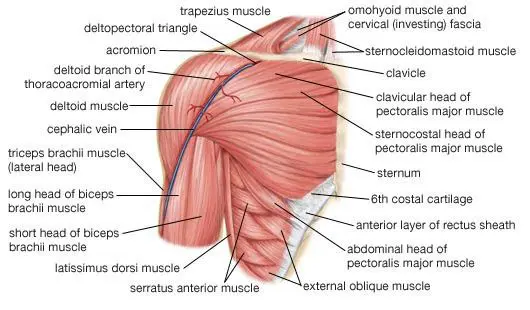
All of this mobility also means the shoulder is one of the least stable joints in the body. Instability can lead to injury, especially when combined with heavy weights and tricky exercises. The muscles of the shoulder can also become weak or tight, which creates imbalances within the shoulder joint. This, too, can lead to injury.
For example, if you do a lot of bench pressing, the pecs and anterior deltoids will get very strong and tight, but the other muscles around the shoulder joint may become weak and lax. This will create imbalances within the shoulder joint that could lead to injury.
The good news is that shoulder pain can be avoided, and if you already have shoulder pain, it can often be cured. Of course, if you have serious shoulder problems, you should always speak to your doctor.
Here are five strategies for building big AND healthy shoulders.
1. Use dumbbells more than barbells and machines
Most exercisers like the barbell bench press and shoulder press. They are, after all, great muscle builders. However, both types of barbell press force you into a very fixed movement pattern, and that can be hard on your shoulders. The same true for most machines. Your shoulders have to accommodate the exercise you are doing, and that can be hard on your joints.
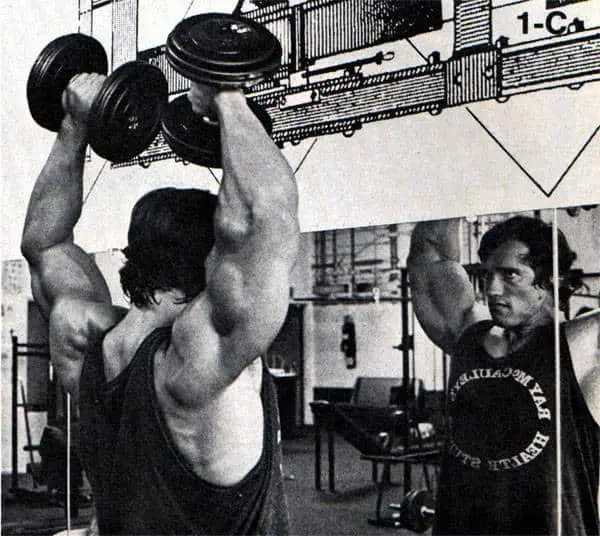
Making the switch from a barbell to dumbbells will allow your arms to move independently, and that can take a lot of stress off your shoulders. You are less “locked-in,” so your joints can move more freely and naturally. If barbell overhead presses and bench presses hurt your shoulders, switching to dumbbells may allow you to continue training hard but without the joint pain.
Level Up Your Fitness: Join our 💪 strong community in Fitness Volt Newsletter. Get daily inspiration, expert-backed workouts, nutrition tips, the latest in strength sports, and the support you need to reach your goals. Subscribe for free!
2. Pull as often as you push
Take a look at your workout; how many sets of pushing exercises do you do compared to pulling exercises? In other words, for every set of chest and shoulders, you should also do a set for your back too. Doing too much pushing and not enough pulling can lead to shoulder muscle imbalances, which will affect your joint alignment and posture.
To avoid this problem, for every set of chest training you do, make sure you also do a set of rows. This will balance your horizontal pushing muscles with your horizontal pulling muscles. Also, for every set of overhead presses, make sure you do a set of pulldowns or pull-ups. This will balance your vertical pushing muscles with your vertical pulling muscles.
Here is an example of a balanced upper-body training workout that follows these guidelines:
| Exercise | Sets | Reps | Recovery | |
| 1 | Dumbbell bench press | 3 | 8 | 90 seconds |
| 2 | Chest supported dumbbell row | 3 | 8 | 90 seconds |
| 3 | Incline dumbbell bench press | 3 | 10 | 60 seconds |
| 4 | Cable rows | 3 | 10 | 60 seconds |
| 5 | Dumbbell shoulder press | 3 | 10 | 60 seconds |
| 6 | Pull-ups | 3 | 10 | 60 seconds |
| 7 | Dumbbell side raises | 3 | 15 | 45 seconds |
| 8 | Cable crossovers | 3 | 15 | 45 seconds |
3. Skip behind the neck exercises
Behind the neck overhead presses and pulldowns are popular exercises, but, for many people, they increase the risk of shoulder pain. Pulling or pressing a bar behind your neck puts a lot of stress on the rotator cuff, especially if you have poor flexibility.
While behind the neck exercises may offer some small advantages for muscle growth, the increased potential for shoulder pain means they are often not worth the risk. If you have existing shoulder pain or just want to reduce your risk of suffering from shoulder problems in the future, you should skip doing behind the neck presses and pulldowns.
4. Strengthen your rotator cuff
While your rotator cuff is involved in every upper body exercise you do, its involvement is purely indirect. In other words, it’s not the target muscle. Lack of direct rotator cuff training can leave this vital muscle group weak and prone to injury.
Avoid this problem by training your rotator cuff a couple of times a week. You can exercise these muscles using resistance bands so you can do a rotator cuff specific workout at home. Good resistance band rotator cuff exercises include:
1. Lateral rotations
- Sit or stand with your upper arms by your sides, and your elbows bent to 90 degrees.
- Hold a resistance band in your hands in front of your stomach.
- Rotate your arms outward and stretch the band across your abdomen.
- Return to the starting position and repeat.
2. Medial rotations
- Attach a resistance band to a waist-high anchor. Stand sideways on and hold the band in your nearest hand.
- Hold your upper arm next to your body and bend your arm to 90 degrees.
- Rotate your upper arm across your abdomen.
- Return to the starting position and repeat.
3. Cross body external rotation
- Place one and of your band under your foot and hold the other end in the opposite hand.
- Raise your arm forward, out, and across your body to just above shoulder-height. Try to create a large arc. Think of this movement as a reverse of cable crossovers.
- Lower your arm and repeat.
4. Horizontal arms external rotation
- Stand on the middle of your band with your feet close together.
- With your elbows bent to 90 degrees, raise your upper arms, so they are perpendicular to the floor.
- Externally rotate your upper arms, raising your hands above your head.
- Return to the starting position and repeat.
5. Keep your shoulders mobile and flexible
Tight muscles are a leading cause of shoulder pain. It’s not enough to strengthen your muscles, they also need to be flexible too. If your muscles are tight, your joints will lose their mobility, and that will affect your range of motion. If you start to lose your range of motion, your joints will not wear evenly.
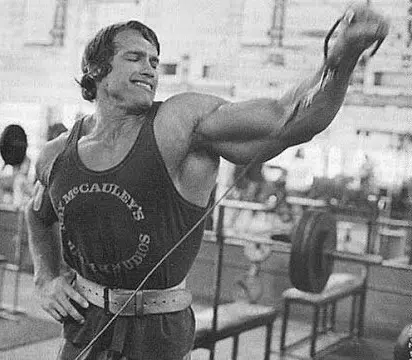
This can lead to osteoarthritis and the formation of bone spurs. Bone spurs are unwanted spikes made of bone that often have to be removed surgically. Needless to say, such problems can be hard to fix.
To test your shoulder mobility and flexibility, lie on the floor with your legs bent and feet flat. Bend your arms and rest your triceps on the floor, 90-degrees to your body. From this position, gently try and lower your palms and then the backs of your hands to the floor. Make sure your upper arm doesn’t move off the floor.
If you are unable to lower your palms to the floor, your external rotators are tight. If you are unable to lower the back of your hands to the floor, your internal rotators are tight.
To fix any tightness, simply repeat the test and hold the endpoint for 60 seconds, gradually trying to reach the floor. Do not force the movement as this could lead to further injury. Instead, rotate your arms very gently so that you only feel mild tension in your shoulders. Stretching is more effective and comfortable after a warm up, for example, after your resistance band rotator cuff workout. Stretch every day for best results.
Wrap up
Just because you lift weights doesn’t mean you have to have painful shoulders. After all, don’t you want to look good AND feel good too? Use the information in this article to keep your shoulder joints and muscles healthy. That way, you’ll be able to train without pain and build even bigger delts.
References:
- Pubmeddev; WL, Westcott. “Resistance training is medicine: effects of strength training on health. – PubMed – NCBI”. www.ncbi.nlm.nih.gov.
- Encyclopaedia Britannica: “Human muscle system – The shoulder”. Encyclopedia Britannica.



